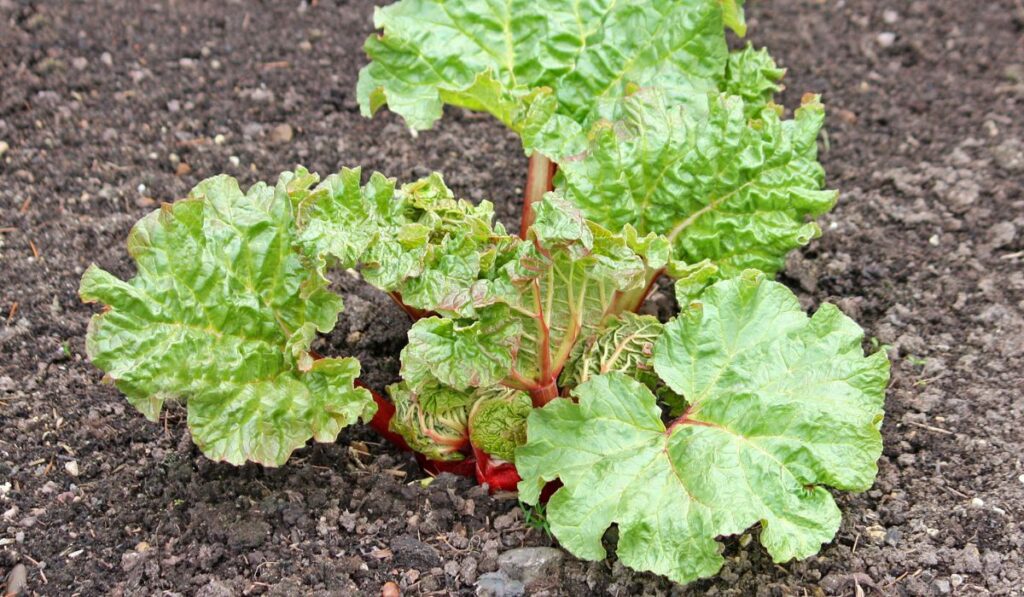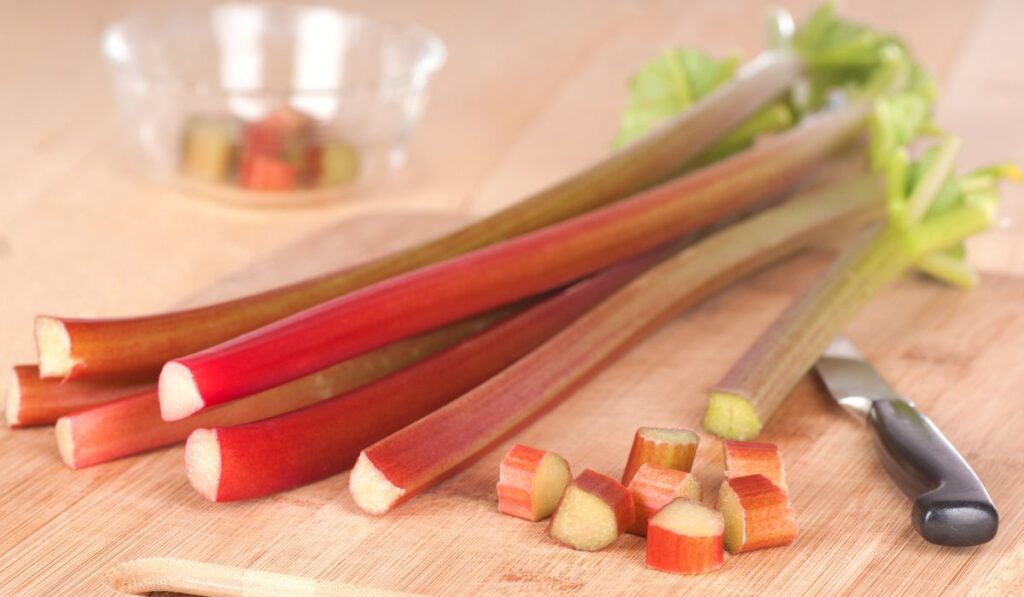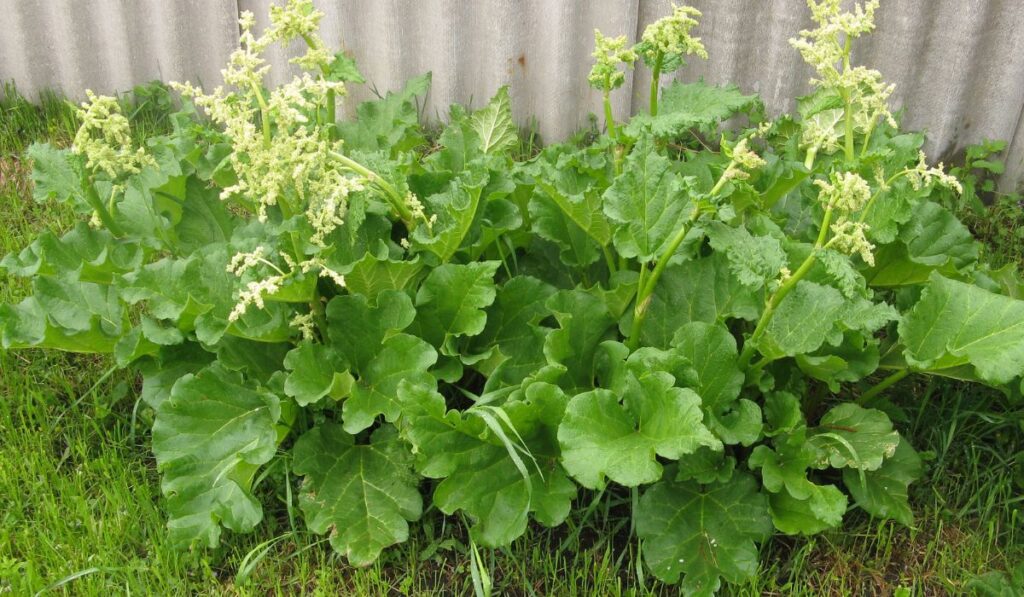You either like rhubarb, or you don’t, but most people will agree this delicious vegetable works great in sauces, pies, crumble, and homemade jams. Best of all, it’s a hardy, undemanding perennial that needs a cold snap to yield the best crops. Here’s what to know about growing and caring for rhubarb.
The best time to grow rhubarb is in the spring when the ground has thawed. Water the plants adequately during the growing season, keeping the soil moist but not soggy. Carry out routine care and maintenance practices like mulching and controlling pests and diseases to help the plants thrive.
Healthy rhubarb plants remain productive for several years to come, making them a great investment. Moreover, rhubarb adds beauty to your garden with its blocky, ruby stems and large leaves. Let’s get started so you know how to grow and care for this tart-flavored veggie.
When is the Best Time of Year to Grow Rhubarb?

The best time to plant rhubarb (on Amazon) is in spring, a couple of weeks after all the danger of spring frost has passed. While rhubarb is a cool-weather vegetable, a hard freeze will destroy its ground leaves and petioles, so you must protect the plants by growing them after the last frost date.
Another reason for planting rhubarb crowns in the spring when the ground is not frozen is to give you an easy time working the soil. The roots are typically dormant before growth begins, even as the plants first sprout.
As a rule of thumb, plant rhubarb when the soil temperature is at least 50℉ (you might want to use a digital soil thermometer for that).
While spring is the best time to grow rhubarb, you can also plant the crowns or budded pieces in the fall while the soil is warm and moist. Then, if you plant them in the fall after dormancy has kicked in, you’ll have the plants cropping in the spring.
If you prefer to raise rhubarb in pots initially, you can plant them out at any time of the year, provided the soil is warm and adequately moist.
Water your newly planted rhubarb crowns, keeping an eye on the soil to ensure it’s not waterlogged at any time. You must apply a 2-inch layer of organic mulch to conserve moisture. Be sure to replenish the mulch throughout the Rhubarb growing season.
Is Rhubarb a Perennial?
Rhubarb is a true perennial vegetable, and you can expect the crop to return yearly. Healthy rhubarb plants will remain productive and yield harvests for 8 to 10 years or longer. Provided you don’t notice any significant yield declines over these years; you don’t have to replace the plants.
While the plants make an excellent investment, they don’t transplant easily once established. That said, be careful while choosing your planting site. Moreover, you want to start with the best plants you can get.
Being a perennial, you must divide established rhubarb plants every 5 to 10 years. You’ll know it’s time to do so when the stems appear crowded and thin. Divide the plants in the early spring or fall when they’re dormant.
What Climates Can Rhubarb Grow in?
Rhubarb thrives in cool temperate climates, making it a favorite perennial vegetable among northern gardeners.
The plants do best in areas where the average winter temperatures fall below 40 ℉. They need at least 500 hours of winter temperatures ranging between 27 ℉ and 40 ℉ to form new leaf buds.
While rhubarb requires a dormancy period to thrive and produce plenty of stalks, the plants need spring temperatures above 40 ℉ to break dormancy and stimulate growth. For vigorous vegetative growth, the summer temperatures should be below 75 ℉.
Understandably, most people like the pink-to-red stem pigment in rhubarbs. The combo of low spring temperatures and cultivar genetics comes in handy to produce this favorite pigmentation internally and externally.
On the other hand, high temperatures make the petioles develop a green hue, which most people will balk at. So if you somehow grow rhubarb in the warmer southern states, you’ve got to give the plants some late afternoon shade in the summer to keep their environment cooler.
How to Harvest Rhubarb
Forget harvesting rhubarb during the first year you plant the crop in your garden. This is to allow the plants adequate time to establish themselves properly.
Your patience will pay off from the second year onwards, as you’ll have a bountiful harvest starting in April. That’s when the stems are 12 inches long, and the leaves have unfurled completely.
Mature plants will give you 8 to 10 weeks of harvest, and you can expect as much as 3 pounds of stalks per plant every season.
Follow these tips for harvesting rhubarb:
- Choose stems 12 to 18 inches (1 to 1 ½ feet) long and reddish. Grasp the stalks near their bases and gently pull outwards, twisting as you do so. You can also use a sharp knife to slice the stems more efficiently from the plants.
- Be sure to sanitize the knife before cutting to ensure you don’t spread disease from infected plants. You also want to cut as close to the crown as possible without damaging it. Finally, remove the leafy portion and the base of the stems, keeping only the colored stalks.
- This is a big one—you can only eat the stems of rhubarb. This is because the leaves are high in oxalic acid, a toxic compound notorious for causing kidney stones. That said, trim away the leaves of healthy plants and add them to your compost heap.
- While rhubarb comes back year after year, you want to finish harvesting by the end of June. Stop harvesting when the stems start getting shorter and thinner. This is to allow the plants enough time to store energy so you can realize a bountiful harvest the following spring.
- You should also harvest lightly, taking off only a few stalks from each plant. From the third year onwards, when the plants are well established, you can harvest freely, but don’t remove more than half of the stalks from any plant.
Storing and Cooking Rhubarb

Don’t worry if you harvest more stems than you can use. Rhubarb freezes remarkably well, and you can also preserve them by pickling. In addition, early stems have the best flavor and tenderness, making them suitable for pies.
Stems you harvest later in the season are typically tougher, so you might want to reserve them for stews, jams, and sauces.
While some believe the entire rhubarb plant becomes toxic as summer temperatures rise, nothing can be further from the truth. The only thing that happens is that summer stalks tend to be tougher than those picked in the spring.
Like in cooking, the best quality stalks for storing are freshly cut ones.
Refrigerate freshly cut rhubarb stalks in a covered container. Alternatively, wrap them in aluminum foil or a zip-type plastic bag and keep them in your refrigerator for a couple of weeks. Then, when it’s time to cook the refrigerated stalks, you can refresh their crispness by standing them in water.
Tips for Avoiding Pests and Disease
While pests and diseases are a rare issue with rhubarb, you should follow these tips to avoid them:
Dealing with Crown Rot
Crown rot is usually due to fungi and bacteria in the soil or water, especially where soils are poorly drained. Once it spreads, the disease can kill the affected plants and take a toll on your yields.
The best remedy is to cut the affected parts and discard them quickly. You might find that you must cut into healthy plant tissue to save the whole plant. You can also dig out and burn entirely affected plants. Resist the temptation to compost them.
Also, avoid planting rhubarb in areas where crown rot has damaged the plants.
Dealing with Rhubarb Curculio
Rhubarb curculio, or rhubarb weevil, is usually a dark-colored, giant beetle (about ½ inch long) with a yellow powdery material on its back.
The beetles puncture leaf stalks from late spring to early summer, all while feeding and laying eggs. Damaged stems then ooze sap and begin to decay.
You can control them by handpicking adults, usually in mid-May. You should also destroy nearby host plants like sunflowers and thistles in mid-summer to prevent curculio from spreading.
How to Deal with Leaf Spots

Leaf spots are usually caused by the fungus, and the worst leaf spot is red leaf, caused by Ramularia fungi. However, it can also spread to the stems, so you should act quickly to control the disease.
Cut away old foliage in autumn to discourage the growth of leaf spots, as the spores usually overwinter in the old debris.
If entire plants are affected, destroy them by burning or burying them in a particular spot where you don’t want to grow any crops—do not compost them.
It’s also not uncommon to find other garden critters, like snails and slugs, nibbling on your tasty rhubarb. You can apply biocontrols or spray them with chemicals to get rid of them.
